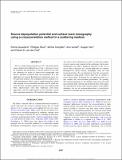| dc.contributor.author | Gouedard, Pierre | |
| dc.contributor.author | Roux, Philippe | |
| dc.contributor.author | Verdel, Arie | |
| dc.contributor.author | Campillo, Michel | |
| dc.contributor.author | Yao, Huajian | |
| dc.contributor.author | van der Hilst, Robert D | |
| dc.date.accessioned | 2012-10-23T16:40:15Z | |
| dc.date.available | 2012-10-23T16:40:15Z | |
| dc.date.issued | 2011-03 | |
| dc.date.submitted | 2010-09 | |
| dc.identifier.issn | 1070-485X | |
| dc.identifier.issn | 0016-8033 | |
| dc.identifier.uri | http://hdl.handle.net/1721.1/74212 | |
| dc.description.abstract | We use seismic prospecting data on a 40 × 40 regular grid of sources and receivers deployed on a 1 km × 1 km area to assess the feasibility and advantages of velocity analysis of the shallow subsurface by means of surface-wave tomography with Green's functions estimated from crosscorrelation. In a first application we measure Rayleigh-wave dispersion curves in a 1D equivalent medium. The assumption that the medium is laterally homogeneous allows using a simple projection scheme and averaging of crosscorrelation functions over the whole network. Because averaging suppresses noise, this method yields better signal-to-noise ratio than traditional active-source approaches, and the improvement can be estimated a priori from acquisition parameters. We find that high-quality dispersion curves can be obtained even when we reduce the number of active sources used as input for the correlations. Such source depopulation can achieve significant reduction in the cost of active source acquisition. In a second application we compare Rayleigh-wave group velocity tomography from raw and reconstructed data. We can demonstrate that the crosscorrelation approach yields group velocity maps that are similar to active source maps. Scattering has an importance here as it may enhance the crosscorrelation performance. We quantify the scattering properties of the medium using mean free path measurements from coherent and incoherent parts of the signal. We conclude that for first-order velocity analysis of the shallow subsurface, the use of crosscorrelation offers a cost-effective alternative to methods that rely exclusively on active sources. | en_US |
| dc.language.iso | en_US | |
| dc.publisher | Society of Exploration Geophysicists | en_US |
| dc.relation.isversionof | http://dx.doi.org/ 10.1190/1.3535443 | en_US |
| dc.rights | Article is made available in accordance with the publisher's policy and may be subject to US copyright law. Please refer to the publisher's site for terms of use. | en_US |
| dc.source | Society of Exploration Geologists | en_US |
| dc.title | Source depopulation potential and surface-wave tomography using a crosscorrelation method in a scattering medium | en_US |
| dc.type | Article | en_US |
| dc.identifier.citation | Gouédard, Pierre et al. “Source Depopulation Potential and Surface-wave Tomography Using a Crosscorrelation Method in a Scattering Medium.” Geophysics 76.2 (2011): SA51. ©2011 Society of Exploration Geophysicists | en_US |
| dc.contributor.department | Massachusetts Institute of Technology. Department of Earth, Atmospheric, and Planetary Sciences | en_US |
| dc.contributor.mitauthor | Gouedard, Pierre | |
| dc.contributor.mitauthor | Verdel, Arie | |
| dc.contributor.mitauthor | van der Hilst, Robert D. | |
| dc.relation.journal | Geophysics | en_US |
| dc.eprint.version | Final published version | en_US |
| dc.type.uri | http://purl.org/eprint/type/JournalArticle | en_US |
| eprint.status | http://purl.org/eprint/status/PeerReviewed | en_US |
| dspace.orderedauthors | Gouédard, Pierre; Roux, Philippe; Campillo, Michel; Verdel, Arie; Yao, Huajian; van der Hilst, Robert D. | en |
| dc.identifier.orcid | https://orcid.org/0000-0003-1650-6818 | |
| mit.license | PUBLISHER_POLICY | en_US |
| mit.metadata.status | Complete | |
